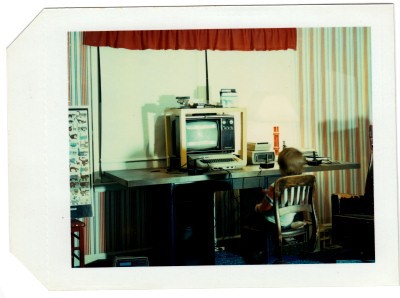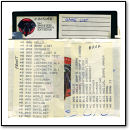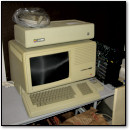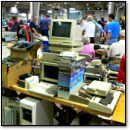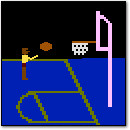Steve Bristow (1949-2015)
Tuesday, February 24th, 2015 [The following news comes to us via video game historian Mary Goldberg, who has allowed VC&G to republish his Facebook announcement here so more people can see it. –Benj]
[The following news comes to us via video game historian Mary Goldberg, who has allowed VC&G to republish his Facebook announcement here so more people can see it. –Benj]
It is with a sad heart that we announce the passing of Atari legend and friend Stephen D. (“Steve”) Bristow, who died this past Sunday, February 22, 2015 at the age of 65 following a short illness.
Bristow was one of the originals, helping Nolan Bushnell out during the development of the world’s first commercial arcade game, Computer Space, while an intern at Ampex.
He then moved to Nutting Associates, the publisher of Computer Space, as an intern. At Nutting, he soon took over for Nolan Bushnell when Bushnell and business partner Ted Dabney left to form Atari.
In the early 1970s, Bristow joined up once again with Bushnell at Atari for a short while before being tapped to form secret Atari subsidiary Kee Games with Joe and Patricia Keenan. There, he lead the creation of several groundbreaking arcade games such as the full-color multiplayer Indy 800 and the seminal game Tank.
Bristow occupied many positions at Atari throughout the 1970s an 80s. Upon the merger between Kee Games and Atari, he oversaw Atari’s Coin Engineering as well as later projects like the Electronic Board Game Division. He later became Plant Manager of Pinball Production at Atari before moving to VP Engineering, Consumer and Home Computer Division, then VP Engineering of Atari’s Consumer Game Division in the early 1980s.
From there, Bristow moved to VP Advanced Technology, then VP Engineering, AtariTel Division (which produced telephone products). Then finally, he joined Atari’s Engineering Computer Division as VP and became an Atari Fellow before leaving Atari all together in February 1984.
Bristow continued with an impressive electrical engineering career afterword, but it’s his time and accomplishments at Atari (and all the fun he brought us) that are the reason we’re all here. He will be sorely missed.
[ Retro Scan of the Week ] The Joust Guy
Monday, August 18th, 2014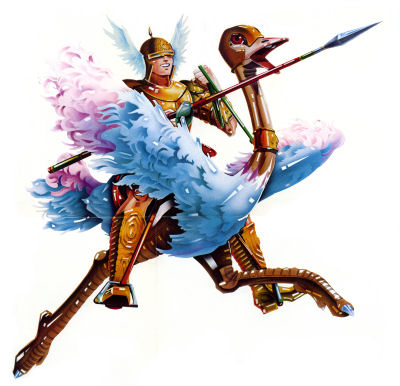 If I were riding a flying ostrich, I’d probably be smiling too.
If I were riding a flying ostrich, I’d probably be smiling too.
I don’t normally take scans out of context, but I made an exception for this amazing illustration. It comes from the instruction manual for Joust for the Atari 2600. I isolated the image years ago for possible use in one of my Halloween costume ideas posts, and I’ve been staring at it in my scans folder ever since.
Joust is one of my favorite arcade titles, and I’m particularly fond of the Atari 7800 home version.
I’d like to find out who created this glorious piece of video game art. I’ll do some digging in a bit, but if you know already, please leave a comment and I’ll update this post. (The illustrator may be referenced in the manual itself, but it’s packed where I can’t get to it.)
By the way, I think this illustration would look awesome on a t-shirt. Anybody want to make one?
Discussion Topic of the Week: Which is better: Joust or Balloon Fight?
[ Newsbits ] June 6, 2014
Friday, June 6th, 2014

Despite what you may think, Newsbits is not dead. It just needs more fiber.
Recent News
- The RetroN 5 Launching June 6th (Today!) in the US
(Source: Destructoid)Hope it works as advertised.
This thing is a beast, supporting NES, Famicom, SNES, Super Famicom, Genesis, Mega Drive, Game Boy, Game Boy Color, and GBA cartridges. All of that, with 720p output via HDMI and original controller support.
- Wii U plugs first DS game into Virtual Console in Japan
Once upon a time, Nintendo frowned strongly upon emulation. Now its business model depends on it. Oh, how times have changed.
Puzzle-poser Brain Age is the first DS game to arrive on Wii U Virtual Console, and it’s out now in Japan for free until June 30.
- Unearthed E.T. Atari games will be curated by New Mexico space museum and then sold
(Source: Polygon)A unique situation where one of these games in unopened, mint condition could be worth far less than one crushed and buried in a landfill for 30 years.
Seven hundred of the 1,300 E.T. and other Atari cartridges recovered from a New Mexico landfill will be appraised, certified and put up for sale, the Alamogordo City Commission decided this week.
- The Verge Publishes Rarely-Seen Photos of Apple’s 1980s Prototype Case Designs
(Source: The Verge)Incredible photos of early 1980s Apple products that never were
Some of its earliest and most iconic designs, however, didn’t actually come from inside of Apple, but from outside designers at Frog. In particular, credit goes to Frog’s founder, Hartmut Esslinger, who was responsible for the ‘Snow White’ design language.
- Watching kids trying to figure out how to use an old Apple II is totally hilarious
(Source: Cult of Mac)
This video of children from the ages of 6 to 13 trying to figure out how to work a vintage Apple II … shows just how inexplicable computing was to pretty much everyone before Steve Jobs released the original Mac in 1984.
- Modder Stuffs a Raspberry Pi into a Game Boy Pocket
(Source: Hackaday)This is one of the most amazing mods I’ve ever seen
After sanding down the bosses on the inside of the case, gluing the battery door shut, and installing a bit of plastic over the cartridge slot, WarriorRocker was able to fit a Raspi inside. The buttons use the same PCB as the stock Game Boy, connected to a Teensy 2.0 board that simulates a USB keyboard.
- Exhibiting .gifs: An Interview with curator Jason Eppink
(Source: The Signal)Wonder if they know about Retro GIF of the Week
Jason recently curated ‘The Reaction GIF: Moving Image as Gesture,’ which exhibits a set of GIFs he identified in consultation with redditors.
Cool Links
- Where Have You Gone, Peter Norton?
(Source: Technologizer)A look back at the PC utility guru’s career by Harry McCracken at the newly-reborn Technologizer
Norton’s empire grew to include multiple software products, articles (including a long-running PC Magazine column), and books. He was everywhere that PCs were. And then, in 1990, he sold Peter Norton Computing to Symantec, which made the Norton line of software even more successful.
- Wolfenstein game graphics, 1992 vs 2014
(Source: Twitter)A million more pixels, but the jaw remains the same
- The Most 90s Thing That Could Ever Exist
(Source: The Atlantic)
The zeitgeist summed perfectly in one technological artifact, which is a VHS tape promoting Windows 95, starring Jennifer Aniston and Matthew Perry.
- Total Chaos is the Best-Looking Doom II Mod You’ve Ever Seen
(Source: PCGamer)More like a “GZDoom mod,” but still very impressive.
Total Chaos doesn’t run on the Doom 2 engine from 1993 proper, but a modified version of the original source code that brings in OpenGL, mouse looks and other features like 16x motion blur, high resolution textures, 3D models, and bloom effects.
- The Secret History of Hypertext
(Source: The Atlantic)
Historians of technology often cite Bush’s essay as the conceptual forerunner of the Web. And hypertext pioneers like Douglas Engelbart, Ted Nelson, and Tim Berners-Lee have all acknowledged their debt to Bush’s vision. But for all his lasting influence, Bush was not the first person to imagine something like the Web.
- The Woman Behind Apple’s First Icons
(Source: Priceonomics)…and Windows 3.0 to XP’s Solitaire cards! (I did an interview with her about that once, gotta find it.)
For many, Susan Kare’s icons were a first taste of human-computer interaction: they were approachable, friendly, and simple, much like the designer herself. Today, we recognize the little images — system-failure bomb, paintbrush, mini-stopwatch, dogcow — as old, pixelated friends.
Submit News
If you want me to include something on a future Newsbits column, send me an email with “Newsbits” in the subject line.
[ Newsbits ] May 1, 2014
Thursday, May 1st, 2014

Recent News
- See Atari’s Buried Treasure: E.T. Among 30 Retro Games Unearthed In The Desert
I never thought I’d live to see the day“The legend was true, but that’s not all. Atari buried a lot of stuff back in 1983–and this is just the tip of the iceberg.
- Andy Warhol’s Amiga Computer Art Found 30 Years Later
Always felt Amiga + Warhol was one of the more bizarre partnerships in computer history“The Andy Warhol Museum has recovered a set of images, doodles, and photos created by the seminal pop artist on a Commodore Amiga home computer. The artworks, made by Warhol as part of a collaboration with Commodore Amiga, had been stranded on Amiga floppy disks for almost twenty years after the artist saved them in the mid-1980s.
- ICHEG Preserves Atari Coin-Op Divisions Collection
It gives me great mental relief to know someone is doing this so well and so thoroughly“ICHEG has acquired a massive collection of materials chronicling the history of Atari’s pioneering video arcade and pinball machine divisions from 1972 to 1999. The collection represents the largest and most comprehensive assemblage of archival records and other documentary items related to Atari’s coin-operated games anywhere in the world.
- Bob Hoskins, Actor Who Played Mario, Dead at 71
Now both live-action Marios are gone“Bob Hoskins, the pugnacious British actor known for playing gangsters, tough guys and working-class gentlemen in such films as ‘Who Framed Roger Rabbit,’ ‘The Long Good Friday’ and ‘Mermaids,’ has died, publicist Clair Dobbs said Wednesday.
- Fifty Years of BASIC, the Programming Language That Made Computers Personal
Harry McCracken’s epic study of BASIC on its 50th“Once upon a time, knowing how to use a computer was virtually synonymous with knowing how to program one. And the thing that made it possible was a programming language called BASIC.
- A Short History of BASIC, as Told in Animated GIFs
An animated supplement to McCracken’s BASIC story above“I used a neat program called Camtasia and some post-processing in Photoshop to create animated GIFs capturing what I saw as I loaded some significant BASIC programs, listed the code and then ran it.
- Sony Quietly Removes Ability to Download PSP/PS One Games Unlocked a Few Days Ago on PS Vita
An update to last week’s Vita story“A few days ago we reported about Sony suddenly unlocking a large amount of PSP games and PlayStation Classics for download and play on the PS Vita. Unfortunately its time to mourn, as that ability was quietly removed this morning. None of those games is available for download anymore.
- Atari Landfill Tweet from Scott Weinberg
“My generation buried those E.T. Atari cartridges for a reason. You’re awakening something not even Lovecraft could imagine.
Cool Links
- Jim and Charlie Gerrie’s Basic Game Programs and Other Software for the TRS-80 MC-10
The underrated MC-10 gets some programming love - “Drunk Hunt” NES Cartridge Flask
“We wanted our product to look and feel exactly like the game cartridges we grew up with, and then BAM SUPRISE! it holds your favorite real-life health potion. Amiright? Amiright?
- A Game Boy That Looks Like It Could Survive Ten Thousand Years
Kotaku’s Plunkett examines a neat Game Boy mod“Vadu Amka’s ‘Brick’ work turns an old Game Boy into a brick wall from the Zelda series.
- L.E.D. Zeppelin Photo
Amusing promotional tweet from Atmel“And for their next hit, L.E.D. Zeppelin presents ‘DI’Yer Maker!’
- BBEdit on System 6 on a Galaxy Note 3
Twitter user @bergmayer hooked up an original Mac mouse and keyboard too
Submit News
If you want me to include something on a future Newsbits column, send me an email with “[Newsbits]” in the subject line.
[ Retro Scan of the Week ] Low-End Virtual Reality
Tuesday, January 7th, 2014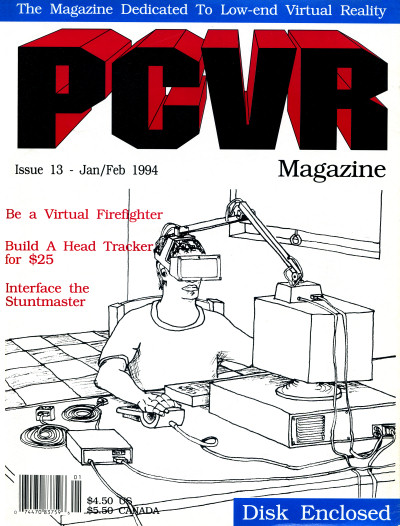 Every new idea is an old idea with more transistors.
Every new idea is an old idea with more transistors.
A few years ago, a relative gave me a couple issues of PCVR Magazine, a low-circulation 1990s periodical dedicated to virtual reality. Here’s the cover of the Jan/Feb 1994 issue, which features an illustration of the magazine’s build-it-yourself head tracker project.
In the early 1990s, the “virtual reality” concept hit a peak in the popular media that coincided with dozens of companies pursuing motion-tracking head-mounted displays — both with honest attempts and blatant gimmicks.
If I had to guess why VR exploded in the popular tech consciousness at that particular time, I would trace it it to the emergence of small, relatively low-cost color LCDs — the kind that made portable consoles like the Atari Lynx and Sega Game Gear possible. Compared to bulky, power-hungry CRT displays, the (relatively) thin, low-power LCDs could be worn on the head with mobility and without too much discomfort. That prompted a minor Cambrian explosion of VR headset hardware.
But the display technology just wasn’t there yet. Affordable LCDs were very low resolution (think 320×200 or less), and higher-resolution LCDs cost thousands of dollars a piece.
In addition, the hardware and software required to generate convincing virtual reality experiences were neither affordable nor generally available. So genuinely immersive VR found itself stuck in corporate and university research labs; meanwhile, the public got trickle-down fad headsets like the Stuntmaster.
Today, we find ourselves in the middle of a VR renaissance thanks to Oculus Rift. But this time, we may actually be at the edge of mainstream virtual reality headsets because the technology has come quite a long way since 1994. I look forward to meeting your 3D virtual avatar in cyberspace soon.
Discussion Topic of the Week: Have you ever used a virtual reality headset of any kind? Tell us about it.
—
See Also: Retro Scan of the Week Special Edition: “At Last! Reality For the Masses!” (VC&G, 2007)
See Also: The History of Stereoscopic 3D Gaming (PC World, 2011)
[ Retro Scan of the Week ] Doom is 20
Monday, December 9th, 2013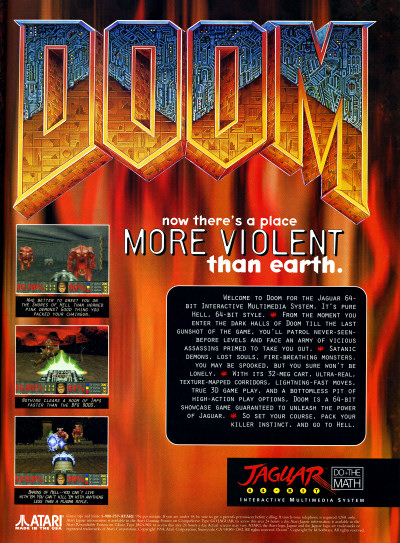 One of the best reasons to own a Jaguar circa 1994
One of the best reasons to own a Jaguar circa 1994
Twenty years ago this week, id Software launched one of the most important and influential PC games of all time: Doom. It started as a modest shareware download but grew to change the entire video game industry. To explain how, here’s 2009 Benj writing about the title for a PC World slideshow:
Id’s archetypical first-person shooter triggered a sea change in the PC game industry, which had formerly been dominated by slow, plodding strategy turn fests, brainy simulations, and stilted PC action titles of yore.
In contrast, Doom was the first of a new generation of fast-paced, smooth action titles that utilized new visual techniques to push PC hardware to its limits. With Doom, PC gamers could experience fluid gameplay, graphics, and sound that easily topped what was found on home game consoles of the day — an uncommon achievement at that point.
Moreover, it introduced exciting new network multiplayer options that are widely imitated to this day, coining the term “deathmatch” in the process.
From its lowly roots as a MS-DOS shareware title, Doom spread like a weed to other platforms, including game consoles, which now count first-person shooters as one of their best-selling genres.
“Doom defined the 3D shooter genre and made multiplayer gaming mainstream,” says Tim Sweeney (founder of Epic Games and creator of the Unreal Engine), “And it did them with such incredible polish, artistry, and foresight that it created an industry.”
Considering that Doom launched in 1993 via shareware channels, I’m not aware of when or in what publication the first advertisement for Doom appeared. (I believe GT Interactive became distributor for the full, boxed PC version of Doom much later, but I could be mistaken.)
So instead, I found this nifty November 1994 scan for the Atari Jaguar version of Doom. I received this version of the game for Christmas in 1994, and it was an amazing gift.
Pushing the PC Limits, Jaguar Relief
Most people don’t remember how much horsepower Doom required in a PC at the time — at least 4 MB of RAM, a mid-range 486 CPU, and a sound card to run passably well. So I had trouble running the game on any PC up to that point.
In 1993, we had one 486 in the household with exactly 4 MB of RAM (to contrast, my personal PC sported a 16 MHz 386 and 2MB RAM), and I had to make a special 5.25″ boot disk that loaded fewer resident DOS drivers, etc. so I could run Doom on that 486 at all. If I recall correctly, I didn’t have enough spare RAM to load the SoundBlaster drivers at boot, so the experience was limited. My friend had to run Doom on his mom’s 486 the same way. Even then, the game didn’t run at full frame rate. Doom pushed the limits.
So coming from that environment, it was an amazing convenience to just plug a Doom cartridge into the Jaguar and play, full-speed, full-screen, with glorious sound and no hiccups. My brother and I played a lot of Doom on that console well into 1996 — until I got a more powerful PC that could run Doom with ease.
Until the PlayStation port of Doom came out (late 1995), the Jaguar port was widely considered the best port of the game (in terms of screen window size, lighting effects, monster interaction, sound, controls, and frame rate) available on consoles. Its biggest drawback was lack of a soundtrack during gameplay. I think that’s because John Carmack used the Jag’s DSP co-processor to handle graphics routines instead of music, which was unconventional on that platform.
But I digress. What a great game. I still play Doom regularly via modern source ports on the PC — most recently on my new 1080p big screen TV set. Add on Xbox 360 controller support via ZDoom, and you’ve got Doom heaven. It’s a game that never seems to get old for me, even 20 years on. That’s the mark of a true classic in my book.
Discussion Topic of the Week: How did you feel when you first played Doom? What are your memories of the occasion?
[ Retro Scan of the Week ] Jaguar on Clearance (Atari Jaguar Turns 20)
Monday, November 11th, 2013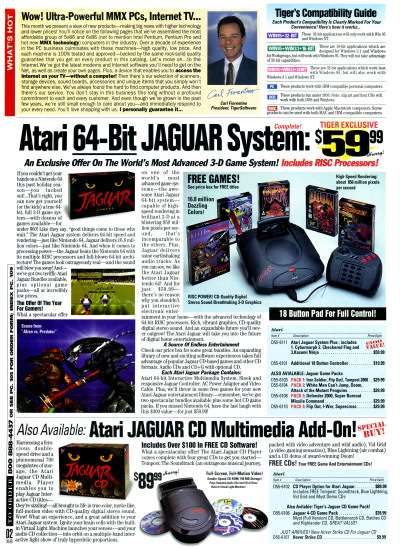 Atari Jaguar on Sale in 1997: “Includes RISC Processors!”
Atari Jaguar on Sale in 1997: “Includes RISC Processors!”
The Atari Jaguar launched at retail 20 years ago this Friday — November 15, 1993.
In April 1994, I received a Jaguar for my birthday, and it was one of the most exciting days of my life. By Thanksgiving of that year, my parents gave me Doom for the Jaguar, and I had a blast. After that, not many truly great games came out for the Jaguar (I’d say Tempest 2000 is the system-exclusive standout).
Partly because of that lack of great software, the Jaguar sunk fast — especially in the face of strong competition from Sony, Sega, and Nintendo (throw in some 3DO and Neo-Geo in there as well). The mid-1990s was a hard time to be a video game console.
By 1997, the Jaguar was toast. If I recall correctly, TigerDirect bought up a huge inventory of unsold Jaguar and Jaguar CD systems and sold them through their catalog.
This scan is a page from a 1997 TigerDirect catalog advertising the Jaguar for a mere $59.99 and the CD add-on for $89.99. Lucky for me, this is how I bought my Jaguar CD system, along with the advertised ultra-cheap game packs. CD exclusives Myst and Cybermorph 2 were worth the purchase alone.
So happy birthday, Jag. Sorry I can’t write more about you now. But I’ve written a lot about you on VC&G in the past. To read more, check out the links at the bottom of this post.
Discussion Topic of the Week: What’s your favorite Atari Jaguar game?
—
See Also: Rayman and Frustration (RSOTW, 2013)
See Also: Atari Jaguar Debut Photo (RGOTW, 2013)
See Also: War + Mech = “Kinda Cool” (RSOTW, 2007)
See Also: Anatomy of a Young Collector’s Room (2006)
See Also: The First Atari Jaguar Press Release (2005)
[ Retro Scan of the Week ] The Halley Project
Monday, August 5th, 2013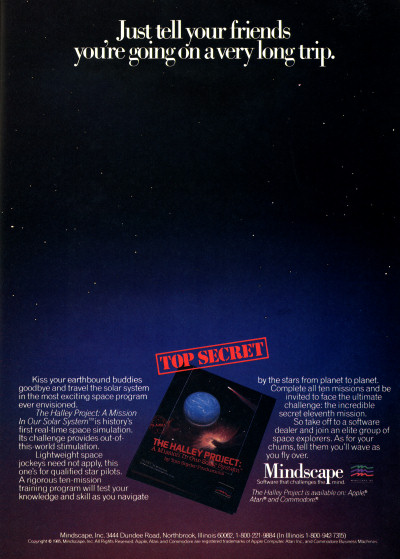 “Just tell your friends you’re going on a very long trip.”
“Just tell your friends you’re going on a very long trip.”
As a kid, The Halley Project blew my mind.
I remember flying through the solar system, first person, in what seemed like a real-time simulation of space flight. All the distances between and positions of the planets were accurate, and you could visit each one by traversing the vast gulfs between them. It was one of the most awe-inspiring games on the Atari 800.
I haven’t sat down and played The Halley Project in at least a decade, so I’m kinda fuzzy about the point of the game. I believe you’re trying to track down Halley’s Comet. On the way, I think you have to make stops at each of the planets in our real solar system. And, if I’m not mistaken, there’s something special about the comet itself (once you actually find it) that I won’t spoil for you guys.
The real Halley’s Comet made a famous fly-by of our planet back in 1986. I still have vague memories of being awakened in the middle of the night when I was 5 so our family could drive out to a local school field and catch of glimpse of the comet. I remember seeing a fuzzy dot, perhaps through binoculars or a simple telescope. That real life celestial visit inspired a sort of frenzy in the media and popular consciousness here in the US, and I’m guessing this game played off of that.
I know I could look up the real plot / purpose / gameplay of The Halley Project online, complete with screenshots and analysis, but I don’t want to. My warm memories are good enough.
Discussion Topic of the Week: Did you see Halley’s Comet in 1986? Tell us about it.
[ Retro Scan of the Week ] Rayman and Frustration
Monday, June 10th, 2013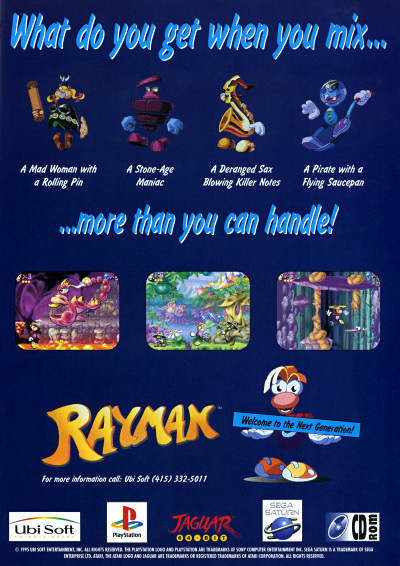 Rayman: Missing limbs since 1995
Rayman: Missing limbs since 1995
I bought Rayman for the Atari Jaguar shortly after it came out in 1995, hopeful it would bring some Mario-style platforming magic to Atari’s “64-bit” machine. While lushly illustrated with a deep color palette, I found the gameplay and the controls a little kludgy, and I had trouble advancing past one of the first few stages. I gave up and moved on to other games.
Shorty thereafter, I lent Rayman and my Jaguar to my brother and his roommate to play at college, and they beat it within a few days. Determination was just as important as skill when it came to completing video games in those days, and I had no motivation to torture myself with a frustrating game.
Which brings me to a tangential point: When I was a kid, if I couldn’t beat a video game, I thought it meant that I was a bad video game player. I thought it was my fault. But years later I realized that the games that frustrated me most were just poorly designed.
Not to say that all difficult games are bad games — in fact, I’d say there’s a big difference between “difficult” and “frustrating.” Merely difficult games are still fun even if you fail; they make you want to try again to complete a challenge. Frustrating ones feel unfair and make you want to smash your game console with a hammer.
One of my friends did that to his NES once. He also threw it off his second story apartment balcony. Ah; those were the days.
Discussion Topic of the Week: Have you ever visited physical violence against a video game console or controller?
